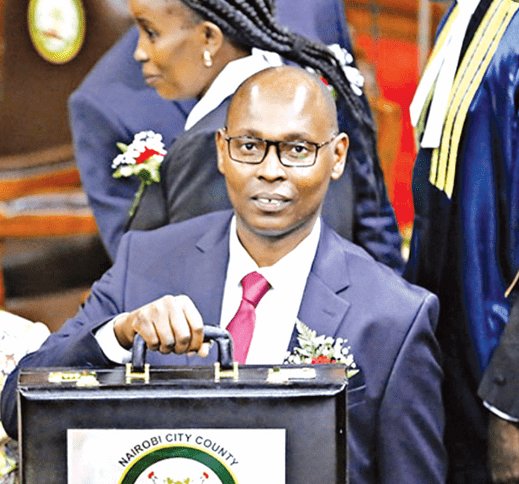Road projects to top list of allocations in Sakaja budget

Road projects and the County Assembly are the biggest beneficiaries of the Nairobi county government’s Sh43.56 billion budget for the financial year 2024/2025.
Nairobi Governor Johnson Sakaja aims to collect Sh21.06 billion in own source revenue in the financial year that started on July 1.
The Sh43.56 billion new budget is an increase from Sh42.3 billion for the financial year 2023/2024, making it the highest ever recorded in Nairobi.
Out of the billions, the projected national transfers amount to Sh22.5 billion, which includes grants, while the total projected Own Source Revenues amount to Sh20.06 billion and hospital facilities improvement financing (FIF) of Sh1 billion.
While reading the budget statement, CEC for Finance Charles Kerich stated that Sakaja’s Sh42.3 billion comprises recurrent and development expenditures at Sh29.3 billion and Sh14.2 billion, respectively.
“The allocation of development is equivalent to 33 per cent of the total budget, which is in line with Section 107 of the Public Finance Management Act, 2012, which requires at least 30 per cent to be allocated to development.,” Kerich said.
To enhance pedestrian safety and connectivity through the construction and rehabilitation of roads, street lighting, stormwater drainage, and bridges, Sh2.9 billion has been allocated.
This will facilitate the implementation of development projects in the sector.
“The priority area for this sector will be to enhance pedestrian safety and connectivity through the construction and rehabilitation of roads, street lighting, stormwater drainage, and bridges. The completion of ongoing road works will be targeted as a key priority, together with the rehabilitation of already completed works,” Kerich stated.
The county assembly has been allocated Sh3.56 billion for its operations, an increase from Sh3.25 billion last year.
The funds will enable the assembly to carry out functions like paying MCAs allowances, administration, renovations, staff salaries, and maintenance, as well as exercise its roles, which include approval of laws and oversight.
Ward Development Programme (WDF) is aimed at reducing disparities in resource allocation and development across all wards and has been allocated Sh1.95 billion.
Ward programmes
The CEC Finance noted that the implementation of ward programmes has been faced with various obstacles, leading to delayed implementation of projects and therefore denying Nairobians much-needed services. “The County Treasury has embarked on the payment of completed certificates, paving the way for a seamless implementation of ward projects in the coming financial year,” Kerich assured.
For equipping and stocking sufficient drugs and non-pharmaceuticals in the county health facilities, Sh200 million was allocated, which is a decrease from Sh400 million in the last budget.
At the same time, Sh1.1 billion has gone towards the construction, equipping, and rehabilitation of health facilities to ensure affordable health services.
To support needy students through the provision of bursaries, the county has allocated Sh857 million for the provision of bursaries to needy students.
Out of this, Sh7 million will be allocated to every ward, and the balance will be available to sponsor all continuing students under the Executive Scholarship Programme.
In order to develop talent among the youth, Kerich allocated Sh826 million for the construction and rehabilitation of stadiums, which serve as recreation centres for the youth.
To support traders within the county in transacting their business in a dignified manner, Sh826 million was allocated for the construction and rehabilitation of markets.
In his manifesto, Governor Sakaja promised to construct 20 new markets across Nairobi.











